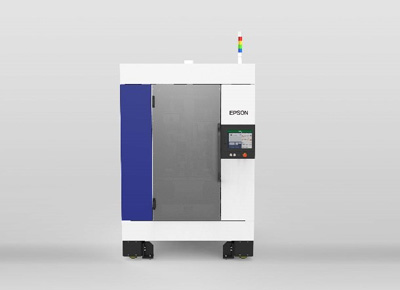A much-anticipated shift is happening in the imaging industry, as 2D printer makers along with camera manufacturers hedge bets at the dawn of the digital era. Among the last hold outs, Seiko Epson Corporation (TSE: 6724, “Epson”) has introduced its first 3D printer.
Though the company hasn’t given the system a name, Epson has said that the printer relies on a flat screw, like those found in the company’s injection molding machines, to extrude third-part materials. This includes resin and metal pellets. Epson says that “the amount of material injected is precisely controlled by regulating the pressure within the head and by regulating the action of a valve in concert with the modeling speed. The temperature at the surface of a piece being printed must also be controlled in order to obtain the required strength. Epson employs a unique mechanism to precisely control this temperature and achieve both strength and accuracy.”
Epson claims that the technology is capable of producing “strong, accurate industrial parts.” The company is targeting final part production and mass customization in small batch production. The printer is undergoing some refinement as Epson itself uses the technology internally to 3D print parts for commercial and industrial equipment at volume. Beyond industrial 3D printers such as this, Epson aims to work with partners to create high-throughput production machines that “reduce environmental impacts.”
A number of others in the imaging sector have gradually been making their way into 3D printing, with HP obviously investing the most with its Multi Jet Fusion and Metal Jet lines. Canon and Konica Minolta have long partnered with 3D Systems to sell its products. Canon in particular has explored the development of at least one 3D printer. More recently, Konica Minolta began selling 3D printing services with Markforged technology in Australia.
Mimaki has expanded from industrial 2D printing to inkjet 3D printing. Ricoh is building up its AM business, offering 3D printing services for healthcare and industrial applications. Sindoh, formerly partnered with Ricoh, has developed a variety of 3D printers, including a selective laser sintering machine and a composite extrusion system. Xerox had been flailing for some time, selling its stake in Fuji Xerox to Fujifilm. Now, however, its metal 3D printing technology could reinvigorate the legendary firm.
Outside of 2D printing, there’s the imaging company Nikon, whose market share for cameras has been steadily eaten away at by digital photography as smartphone cameras improve. Nikon entered into the 3D printing market with the acquisition of 3D printing service bureau Morf3D.
Though the news was made quietly, this is a big move for one the world’s biggest manufacturers of computer printers and imaging equipment. It may not be as large as HP, but it took in US$9.5 billion in revenue in 2019. As we move from printed to digital documents, these companies are shifting resources to more profitable, growth sectors.
For Epson, this move was at least seven years in the making, as the company announced its plans to develop a mass production 3D printing technology in 2015. What’s more interesting is that it wants to partner with another firm to develop high-throughput production technology. Perhaps, as Executive Editor Joris Peels suggested in our Dream Mergers and Acquisitions series, a printer company like Canon (or Epson) could scoop up Evolve Additive, which is geared toward mass production. If anyone is at the International Robot Exhibition 2022 at Tokyo Big Sight this week, they can visit Epson in person and ask these questions.
Subscribe to Our Email Newsletter
Stay up-to-date on all the latest news from the 3D printing industry and receive information and offers from third party vendors.
Print Services
Upload your 3D Models and get them printed quickly and efficiently.
You May Also Like
3D Printing News Briefs, June 11, 2025: Sustainability, Automotive Tooling, & More
We’re starting with sustainability news in today’s 3D Printing News Briefs, as EOS has strengthened its commitment on climate responsibility, and Zestep is making 3D printing filament out of eyewear...
3D Printing 50 Polymer Stand-In Parts for Tokamaks at the PPPL & Elytt Energy
Of all the world’s things, a tokamak is one of the hardest, most complex, expensive and exacting ones to make. These fusion energy devices make plasma, and use magnets to...
3D Printing News Briefs, May 17, 2025: Color-Changing Materials, Humanoid Robot, & More
We’re covering research innovations in today’s 3D Printing News Briefs! First, Penn Engineering developed 3D printed materials that change color under stress, and UC Berkeley researchers created an open source,...
Firehawk Aerospace Partners with JuggerBot 3D, Gets $1.25M from AFWERX for 3D Printed Propellants
Texas-based Firehawk Aerospace, an advanced energetic materials firm that works with aerospace and defense applications, announced a strategic partnership with JuggerBot 3D, an Ohio-based large-format 3D printer manufacturer. Together, the...



































